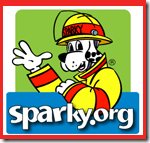Hi everyone! My name is Troy Schoeppner. I am married to Becky Jane, the author of Beyond Five in a Row and Above and Beyond Five in a Row. I am a firefighter for a local city fire department, and I would like to share with you about Fire Prevention Week.Every year firefighters from all across North America take one week in October to help educate children and families about what they should do in case of fire and how to prevent fires from occurring. These efforts usually focus on grade-school age children. Along with my regular visits to area schools, I enjoy making a special effort to reach homeschoolers. I encourage you to take some time during the week of October 7-13 to talk to your children about fire safety.
 Fire Prevention week traces its history back to the Great Chicago Fire. On October 9, 1871 a fire destroyed much of the city and killed more than 250 people and left nearly 100,000 homeless! On the 40th anniversary of this tragic fire, the International Fire Marshals Association of North America sponsored the first Fire Prevention Day. They hoped to increase awareness and educate the public about the importance of fire safety. In 1920, President Woodrow Wilson issued the first National Fire Prevention Day proclamation, and since 1922, National Fire Prevention Week has been observed on the Sunday-through-Saturday period in which October 9 falls.
Fire Prevention week traces its history back to the Great Chicago Fire. On October 9, 1871 a fire destroyed much of the city and killed more than 250 people and left nearly 100,000 homeless! On the 40th anniversary of this tragic fire, the International Fire Marshals Association of North America sponsored the first Fire Prevention Day. They hoped to increase awareness and educate the public about the importance of fire safety. In 1920, President Woodrow Wilson issued the first National Fire Prevention Day proclamation, and since 1922, National Fire Prevention Week has been observed on the Sunday-through-Saturday period in which October 9 falls.
As you discuss fire safety and prevention with your children, remind them that fire can grow and spread through your home very quickly! When the smoke alarm sounds, your family needs to react immediately and know exactly what to do. Your children shouldn’t be afraid of this happening. Instead, they should feel more secure knowing your family is prepared. But remember – Being prepared takes planning and practice!
Here is a list of important steps to help ready your family for a fire emergency:
- Draw a floor plan of your home, marking all doors and windows, and the location of each smoke alarm. If windows or doors have security bars, equip them with quick-release devices.
- Locate two escape routes from each room. The first way out would be the door, and the second way out could be a window. If you must use a second story window as an escape route, seriously consider buying fire escape ladders as a means of emergency escape. And remember, as you exit your home, close all doors behind you to slow the spread of fire and smoke. If smoke or fire blocks your first exit, use your second exit to escape.
- If you must escape through smoke, stay low and crawl under the smoke to safety. Smoke will rise to the ceiling, leaving cooler, cleaner air close to the floor. Crawl on your hands and knees, not belly, because heavier poisons will settle in a thin layer on the floor.
- If you live in a high-rise building, use the stairs – never the elevator – in case of fire.
- As a family, choose a meeting place a safe distance from your home and mark it on the escape plan. A good meeting place would be a tree, telephone pole, or a neighbor’s home. In case of fire, everyone should gather at the meeting place.
- Make sure the street number/address of your home is visible to firefighters.
- Memorize the emergency number of the local fire department. Once outside, call that number immediately from a nearby or neighbor’s phone, or use cell phone you can grab quickly on the way out.
- Practice your escape drill at least twice a year.
- NEVER go back inside a burning building! Once out, stay out!
To find out more about Fire Prevention Week and the “Great Escape,” I highly recommend www.sparky.org. This website is excellent and perfect for exploring with your kids. It is informative and interactive and includes fun games for the kids! You can even go to the parents’ section of the page to sign up for a weekly safety newsletter!
My hope is that each of you will have a safe and happy year!
Troy Schoeppner

